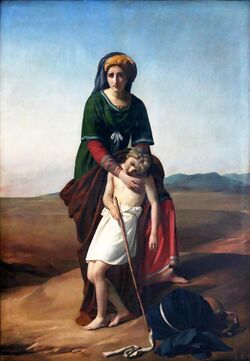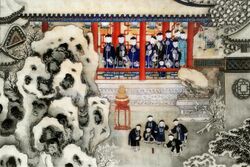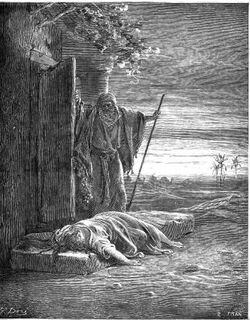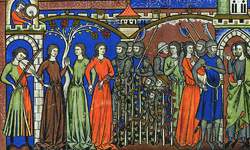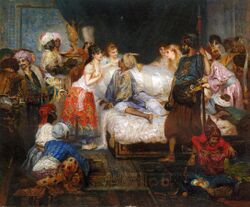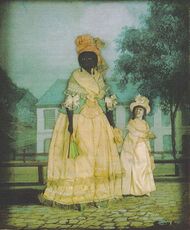Social:Concubinage
Relationships (Outline) |
|---|
Concubinage (/kənˈkjuːbɪnɪdʒ/) is an interpersonal and sexual relationship in which the couple are not or cannot be married. The inability to marry may be due to multiple factors such as differences in social rank status, an existing marriage, religious or professional prohibitions (for example Roman soldiers), or a lack of recognition by appropriate authorities. The woman in such a relationship is referred to as a concubine (/ˈkɒŋkjʊˌbaɪn/), and occasionally so is a man in such a relationship.
The prevalence of concubinage and the status of rights and expectations of a concubine have varied among cultures, as have the rights of children of a concubine. Whatever the status and rights of the concubine, they were always inferior to those of the wife and typically neither she nor her children had rights of inheritance. Historically, concubinage was frequently entered into voluntarily (by the woman or her family) as it provided a measure of economic security for the woman. Involuntary or servile concubinage sometimes involved sexual slavery of one member of the relationship, usually the woman. Nevertheless, sexual relations outside marriage were not uncommon, especially among royalty and nobility, and the woman in such relationships was commonly described as a mistress. The children of such relationships were counted as illegitimate and were barred from inheriting the father's title or estates, even when there was an absence of legitimate heirs.
While forms of long-term sexual relationships and co-habitation short of marriage have become increasingly common in the Western world, these are generally not described as concubinage. The terms concubinage and concubine are used today primarily when referring to non-marital partnerships of earlier eras. In modern usage, a non-marital domestic relationship is commonly referred to as co-habitation (or similar terms), and the woman in such a relationship is generally referred to as a girlfriend, mistress, fiancée, lover or life partner.
In Asia
Concubinage was highly popular before early 20th century all over Asia. The main function of concubinage was producing additional heirs, as well as bringing males pleasure. Children of concubines had lower rights in account to inheritance, which was regulated by the Dishu system.
China
In China, successful men often had concubines until the practice was outlawed when the Communist Party of China came to power in 1949. The standard Chinese term translated as "concubine" was qiè 妾, a term that has been used since ancient times, which means "female slave". Concubinage resembled marriage in that concubines were recognized sexual partners of a man and were expected to bear children for him. Unofficial concubines (Chinese: 婢妾; pinyin: bì qiè) are of lower status, and their children are considered illegitimate. The English term concubine is also used for what the Chinese refer to as pínfēi (Chinese: 嬪妃), or "consorts of emperors", an official position often carrying a very high rank.[1]
In premodern China it was illegal and socially disreputable for a man to have more than one wife at a time, but it was acceptable to have concubines.[2] In the earliest records a man could have as many concubines as he could afford. From the Eastern Han period (AD 25–220) onward, the number of concubines a man could have was limited by law. The higher rank and the more noble identity a man possessed, the more concubines he was permitted to have.[3]
A concubine's treatment and situation was variable and was influenced by the social status of the male to whom she was attached, as well as the attitude of his wife. In the Book of Rites chapter on "The Pattern of the Family" (Chinese: 內則) it says, “If there were betrothal rites, she became a wife; and if she went without these, a concubine.”[4] Wives brought a dowry to a relationship, but concubines did not. A concubinage relationship could be entered into without the ceremonies used in marriages, and neither remarriage nor a return to her natal home in widowhood were allowed to a concubine.[5]
The position of the concubine was generally inferior to that of the wife. Although a concubine could produce heirs, her children would be inferior in social status to a wife's children, although they were of higher status than illegitimate children. The child of a concubine had to show filial duty to two women, their biological mother and their legal mother—the wife of their father.[6] After the death of a concubine, her sons would make an offering to her, but these offerings were not continued by the concubine's grandsons, who only made offerings to their grandfather’s wife.[7]
There are early records of concubines allegedly being buried alive with their masters to "keep them company in the afterlife".[8] Until the Song dynasty (960–1276), it was considered a serious breach of social ethics to promote a concubine to a wife.[5]
During the Qing dynasty (1644–1911), the status of concubines improved. It became permissible to promote a concubine to wife, if the original wife had died and the concubine was the mother of the only surviving sons. Moreover, the prohibition against forcing a widow to remarry was extended to widowed concubines. During this period tablets for concubine-mothers seem to have been more commonly placed in family ancestral altars, and genealogies of some lineages listed concubine-mothers.[5]
Imperial concubines, kept by emperors in the Forbidden City, had different ranks and were traditionally guarded by eunuchs to ensure that they could not be impregnated by anyone but the emperor.[8] In Ming China (1368-1644) there was an official system to select concubines for the emperor. The age of the candidates ranged mainly from 14 to 16. Virtues, behavior, character, appearance and body condition were the selection criteria.[9]
Despite the limitations imposed on Chinese concubines, there are several examples in history and literature of concubines who achieved great power and influence. Lady Yehenara, otherwise known as Empress Dowager Cixi, was arguably one of the most successful concubines in Chinese history. Cixi first entered the court as a concubine to Xianfeng Emperor and gave birth to his only surviving son, who later became Tongzhi Emperor. She eventually became the de facto ruler of Qing China for 47 years after her husband's death.[10]
An examination of concubinage features in one of the Four Great Classical Novels, Dream of the Red Chamber (believed to be a semi-autobiographical account of author Cao Xueqin's family life).[citation needed] Three generations of the Jia family are supported by one notable concubine of the emperor, Jia Yuanchun, the full elder sister of the male protagonist Jia Baoyu. In contrast, their younger half-siblings by concubine Zhao, Jia Tanchun and Jia Huan, develop distorted personalities because they are the children of a concubine.[citation needed]
Contemporary China
The concept of men having relationships with one or more concubines has seen a comeback since modern China has prospered.[according to whom?] Mistresses are often viewed as concubines, inferior to the wife in status.[by whom?]
The women called er nai, unofficial concubines, typically say they feel fine about exploiting their youth, beauty and wombs for the sake of earning money and protection from men.[11][12] They rarely live with the primary wives, as in the past. The one-child policy in Mainland China has encouraged concubinage as men with power and wealth pursue a male heir.[citation needed]
Emperors' concubines and harems are emphasized in 21st-century romantic novels written for female readers and set in ancient times. As a plot element, the children of concubines are depicted with a status much inferior to that in actual history.[citation needed] The zhai dou (residential intrigue) and gong dou (harem intrigue) genres show concubines and wives, as well as their children, scheming secretly to gain power. Empresses in the Palace, a gong dou type novel and TV drama, has had great success in 21st-century China.[citation needed]
Hong Kong, Macau
Hong Kong officially abolished the Great Qing Legal Code in 1971, which makes concubinage illegal. Stanley Ho of Macau took his "2nd wife" as his official concubine in 1957, and his "3rd and 4th wife" retain no official status.[13]
Japan
Before monogamy was legally imposed in the Meiji period, concubinage was common among the nobility.[14] Its purpose was to ensure male heirs. For example, the son of an Imperial concubine often had a chance of becoming emperor. Yanagihara Naruko, a high-ranking concubine of Emperor Meiji, gave birth to Emperor Taishō, who was later legally adopted by Empress Haruko, Emperor Meiji's formal wife. Even among merchant families, concubinage was occasionally used to ensure heirs. Asako Hirooka, an entrepreneur who was the daughter of a concubine, worked hard to help her husband's family survive after the Meiji Restoration. She lost her fertility giving birth to her only daughter, Kameko; so her husband—with whom she got along well—took Asako's maid-servant as a concubine and fathered three daughters and a son with her. Kameko, as the child of the formal wife, married a noble man and matrilineally carried on the family name.[15]
Korea
Joseon monarchs had a harem which contains concubines of different ranks. Empress Myeongseong managed to have sons, preventing sons of concubines getting power.
Children of concubines often have lower value in account of marriage. A daughter of concubine cannot be the wife of a wife-born son of the same class. For example, Jang Nok-su is a concubine-born daughter of a mayor, who was initially married to a slave-servant, later a high-rank concubine of Yeonsangun.
Thailand
Before 1935, the family law listed three kind of wives - official wife, minor wife and slave wife.[16]
Greco-Roman Antiquity
Ancient Greece
In Ancient Greece , the practice of keeping a slave concubine (Ancient Greek: pallakís) was little recorded but appears throughout Athenian history. The law prescribed that a man could kill another man caught attempting a relationship with his concubine for the production of free children, which suggests that a concubine's children were not granted citizenship.[17] While references to the sexual exploitation of maidservants appear in literature, it was considered disgraceful for a man to keep such women under the same roof as his wife.[18] Some interpretations of hetaera have held they were concubines when they had a permanent relationship with a single man.[19]
Ancient Roman concubinae and concubini
Concubinage was an institution practiced in ancient Rome that allowed a man to enter into an informal but recognized relationship with a woman (concubina, plural concubinae) who was not his wife, most often a woman whose lower social status was an obstacle to marriage. Concubinage was "tolerated to the degree that it did not threaten the religious and legal integrity of the family".[20] It was not considered derogatory to be called a concubina, as the title was often inscribed on tombstones.[21]
A concubinus was a young male slave sexually exploited by his master as a sexual partner (see homosexuality in ancient Rome). These relations, however, were expected to play a secondary role to marriage, within which institution an adult male demonstrated his masculine authority as head of the household (pater familias). In one of his epithalamiums, Catullus (fl. mid-1st century BC) assumes that the young bridegroom has a concubinus who considers himself elevated above the other slaves, but who will be set aside as his master turns his attention to marriage and family life.[22]
In Abrahamic traditions
In Judaism
Among the Israelites, men commonly acknowledged their concubines, and such women enjoyed the same rights in the house as legitimate wives.[23]
In ancient Judaism
The term concubine did not necessarily refer to women after the first wife. A man could have many wives and concubines. Legally, any children born to a concubine was considered to be the child of the wife to whom she was under. Sarah had to get Ishmael out of her house because legally Ishmael would always be the first born son even though Isaac was her natural child. The concubine may not have commanded the exact amount of respect as the wife. In the Levitical rules on sexual relations, the Hebrew word that is commonly translated as "wife" is distinct from the Hebrew word that means "concubine". However, on at least one other occasion the term is used to refer to a woman who is not a wife – specifically, the handmaiden of Jacob's wife.[24] In the Levitical code, sexual intercourse between a man and a wife of a different man was forbidden and punishable by death for both persons involved.[25][26] Since it was regarded as the highest blessing to have many children, wives often gave their maids to their husbands if they were barren, as in the cases of Sarah and Hagar, and Rachel and Bilhah. The children of the concubine often had equal rights with those of the wife;[23] for example, King Abimelech was the son of Gideon and his concubine.[27] Later biblical figures such as Gideon, and Solomon had concubines in addition to many childbearing wives. For example, the Books of Kings say that Solomon had 700 wives and 300 concubines.[28]
The account of the unnamed Levite in Judges 19–20[29] shows that the taking of concubines was not the exclusive preserve of kings or patriarchs in Israel during the time of the Judges, and that the rape of a concubine was completely unacceptable to the Israelite nation and led to a civil war. In the story, the Levite appears to be an ordinary member of the tribe dedicated to the worship of God, who was undoubtedly dishonored both by the unfaithfulness of his concubine and her abandonment of him. However, after four months, he decides to make her fall in love with him again at her father’s house; he brings a servant and two asses to show off what glory he has. Her father seeks to keep him there until one day he refuses to remain and leaves. He is offered hospitality at Gibeah. The way in which his host's daughter is offered to the townsmen and the circumstances of his concubine's death at their hands describe a lawless time where visitors are both welcomed and threatened in equal measure. The Levite and his (male) host seek to protect themselves by offering their womenfolk, both the host’s virgin daughter and his companion’s concubine, to their aggressors for sex in exchange for their own safety. In the morning, the Levite tries to wake her up, but then realizes that she is dead. He dismembers her body and distributes her (body parts) throughout the nation of Israel to remind them of the blessing that God gave them of liberating them from the likewise sexually vicious and sadistic land of Egypt, and to inform them of the horribleness of the land of Gibeah. The sadistic rape of the concubine is considered outrageous by the Israelite tribesmen, who then wreak total retribution on the men of Gibeah and the surrounding tribe of Benjamin when they support the Gibeans, killing them without mercy and burning all their towns. The inhabitants of (the town of) Jabesh Gilead are then slaughtered as a punishment for not joining the eleven tribes in their war against the Benjaminites, and their four hundred unmarried daughters given in forced marriage to the six hundred Benjamite survivors. Finally, the two hundred Benjaminite survivors who still have no wives are granted a mass marriage by abduction by the other tribes.
In modern Judaism
In Judaism, concubines are referred to by the Hebrew term pilegesh (Hebrew: פילגש). The term is a loanword from Ancient Greek παλλακίς,[30][31][32] meaning "a mistress staying in house".
According to the Babylonian Talmud,[23] the difference between a concubine and a full wife was that the latter received a ketubah and her marriage (nissu'in) was preceded by an erusin ("formal betrothal"). Neither was the case for a concubine. One opinion in the Jerusalem Talmud argues that the concubine should also receive a marriage contract, but without a clause specifying a divorce settlement.[23]
Certain Jewish thinkers, such as Maimonides, believed that concubines were strictly reserved for kings, and thus that a commoner may not have a concubine. Indeed, such thinkers argued that commoners may not engage in any type of sexual relations outside of a marriage.
Maimonides was not the first Jewish thinker to criticise concubinage. For example, Leviticus Rabbah severely condemns the custom.[33] Other Jewish thinkers, such as Nahmanides, Samuel ben Uri Shraga Phoebus, and Jacob Emden, strongly objected to the idea that concubines should be forbidden.
In the Hebrew of the contemporary State of Israel, pilegesh is often used as the equivalent of the English word "mistress"—i.e., the female partner in extramarital relations—regardless of legal recognition. Attempts have been initiated to popularise pilegesh as a form of premarital, non-marital or extramarital relationship (which, according to the perspective of the enacting person(s), is permitted by Jewish law).[34][35][36]
In Islam
The neutrality of this section is disputed. (August 2014) (Learn how and when to remove this template message) |
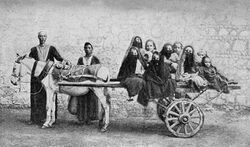
Sexual slavery as concubinage in Islamic sexual jurisprudence is permitted in Islam which was not considered prostitution, and was very common during the Arab slave trade throughout the Middle Ages and early modern period, when women and girls from the Caucasus, Africa, Central Asia and Europe were captured and served as concubines in the harems of the Arab World.[37] Ibn Battuta tells us several times that he was given or purchased female slaves.[38]
Concubinage is permitted and regulated in Islam. Al-Muminun 6 and Al-Maarij 30 both, in identical wording, draw a distinction between spouses and "those whom one's right hands possess" (concubine/sexual slaves), saying " أَزْوَاجِهِمْ أَوْ مَا مَلَكَتْ أَيْمَانُهُمْ" (literally, "their spouses or what their right hands possess"), while clarifying that sexual intercourse with either is permissible. Sayyid Abul Ala Maududi explains that "two categories of women have been excluded from the general command of guarding the private parts: (a) wives, (b) women who are legally in one's possession".[39] "Concubine" (surriyya) refers to the female slave (jāriya), whether Muslim or non-Muslim, with whom her master engages in sexual intercourse. The word "surriyya" is not mentioned in the Qur'an. However, the expression "Ma malakat aymanukum" (that which your right hands own), which occurs fifteen times in the sacred book, refers to slaves and therefore, though not necessarily, to concubines. Concubinage was a pre-Islamic custom that was allowed to be practiced under Islam with Jews and non-Muslim people to marry concubine after teaching her and instructing her well and then giving them freedom.[40] Rationale given for recognition of concubinage in Islam is that "it satisfied the sexual desire of the female slaves and thereby prevented the spread of immorality in the Muslim community."[41] Most schools restrict concubinage to a relationship where the female slave is required to be monogamous to her master[42] (though the master's monogamy to her is not required), but according to Sikainga, "in reality, however, female slaves in many Muslim societies were prey for [male] members of their owners' household, their [owner's male] neighbors, and their [owner's male] guests."[41] Concubines were common in pre-Islamic Arabia and when Islam arrived, it had a society with concubines. Islam introduced legal restrictions to the concubinage[43] and encouraged manumission.[44] In verse 23:6 in the Quran it is allowed to have sexual intercourse with concubines after marrying them, as Islam forbids sexual intercourse outside of marriage.[45] Children of former concubines were generally declared as legitimate as they were born in wedlock, and the mother of a free child was considered free upon the death of the male partner.
According to Shia Muslims, Muhammad sanctioned Nikah mut‘ah (fixed-term marriage, called muta'a in Iraq and sigheh in Iran) which has instead been used as a legitimizing cover for sex workers, in a culture where prostitution is otherwise forbidden.[46] Some Western writers have argued that mut'ah approximates prostitution.[47] Julie Parshall writes that mut'ah is legalised prostitution which has been sanctioned by the Twelver Shia authorities. She quotes the Oxford encyclopedia of modern Islamic world to differentiate between marriage (nikah) and Mut'ah, and states that while nikah is for procreation, mut'ah is just for sexual gratification.[48] According to Zeyno Baran, this kind of temporary marriage provides Shi'ite men with a religiously sanctioned equivalent to prostitution.[49] According to Elena Andreeva's observation published in 2007, Russian travellers to Iran consider mut'ah to be "legalized profligacy" which is indistinguishable from prostitution.[50] Religious supporters of mut'ah argue that temporary marriage is different from prostitution for a couple of reasons, including the necessity of iddah in case the couple have sexual intercourse. It means that if a woman marries a man in this way and has sex, she has to wait for a number of months before marrying again and therefore, a woman cannot marry more than 3 or 4 times in a year.[51][52][53][54][55]
Pre-modern times
In ancient times, two sources for concubines were permitted under an Islamic regime. Primarily, non-Muslim women taken as prisoners of war were made concubines as happened after the Battle of the Trench,[56] or in numerous later Caliphates.[57] It was encouraged to manumit slave women who rejected their initial faith and embraced Islam, or to bring them into formal marriage.
Modern times
According to the rules of Islamic Fiqh, what is halal (permitted) by Allah in the Quran cannot be altered by any authority or individual. Therefore, although the concept of concubinage is halal, concubines are mostly no longer available in this modern era nor allowed to be sold or purchased in accordance with the latest human rights standards. However, as change of existing Islamic law is impossible, a concubine in this modern era, if existing, must be given all the due rights that Islam had preserved in the past.
It is further clarified that all domestic and organizational female employees are not concubines in this era and hence sex is forbidden with them unless Nikah (formal marriage)[58] or Nikah mut‘ah[59] (temporary marriage – which only Shi'ah Islam permits; some Sunni Muslims practice Nikah Misyar, or "traveller's marriage") is committed through the proper channels.
In the United States
When slavery became institutionalized in the North American colonies, white men, whether or not they were married, sometimes took enslaved women as concubines.[60] Marriage between the races was prohibited by law in the colonies and the later United States. Many colonies and states also had laws against miscegenation, or any interracial relations. From 1662 the Colony of Virginia, followed by others, incorporated into law the principle that children took their mother's status, i.e., the principle of partus sequitur ventrem. All children born to enslaved mothers were born into slavery, regardless of their father's status or ancestry.[61] This led to generations of multiracial slaves, some of whom were otherwise considered legally white (one-eighth or less African, equivalent to a great-grandparent) before the American Civil War.
In some cases, men had long-term relationships with enslaved women, giving them and their mixed-race children freedom and providing their children with apprenticeships, education and transfer of capital. A purported relationship between Thomas Jefferson and Sally Hemings is an example of this.[62] Such arrangements were more prevalent in the Southern states during the antebellum years.
Plaçage
In Louisiana and former French territories, a formalized system of concubinage called plaçage developed. European men took enslaved or free women of color as mistresses after making arrangements to give them a dowry, house or other transfer of property, and sometimes, if they were enslaved, offering freedom and education for their children.[63] A third class of free people of color developed, especially in New Orleans.[63][64] Many became educated, artisans and property owners. French-speaking and practicing Catholicism, these women combined French and African-American culture and created an elite between those of European descent and the slaves.[63] Today, descendants of the free people of color are generally called Louisiana Creole people.[63]
See also
- Concubinage in Canada
- Cicisbeo
- Cohabitation
- Common-law marriage
- Courtesan
- Cullagium
- Cuckquean
- Free union
- Monogamy in Christianity
- Morganatic marriage
- Paramour
- Polygamy
- Polyamory
- Polygyny
- Slavery in the United States
References
- ↑ Patricia Buckley Ebrey (2002): Women and the Family in Chinese History. Oxford: Routledge, p. 39.
- ↑ Ebrey 2002:39.
- ↑ Shi Fengyi 史凤仪 (1987): Zhongguo gudai hunyin yu jiating 中国古代婚姻与家庭 Marriage and Family in Ancient China. Wuhan: Hubei Renmin Chubanshe, p. 74.
- ↑ "Nei Ze". http://ctext.org/liji/nei-ze#n9964. Retrieved 11 December 2016.
- ↑ 5.0 5.1 5.2 Ebrey 2002: 60.
- ↑ Ebrey 2002: 54.
- ↑ Ebrey 2002: 42.
- ↑ 8.0 8.1 "Concubines of Ancient China". Beijing Made Easy. Beijing Made Easy. 2012. http://www.beijingmadeeasy.com/beijing-history/concubines-of-ancient-china. Retrieved 13 June 2012.
- ↑ Qiu Zhonglin(Chung-lin Ch'iu)邱仲麟:"Mingdai linxuan Houfei jiqi guizhi" 明代遴選後妃及其規制 (The Imperial Concubine Selection System during the Ming Dynasty). Mingdai Yanjiu 明代研究 (Ming Studies) 11.2008:58.
- ↑ Sterling Seagrave, Peggy Seagrave (1993). Dragon lady: the life and legend of the last empress of China. Vintage Books.
- ↑ "Er nai - the modern Chinese concubine". http://www.beijingmadeeasy.com/beijing-society/er-nai-modern-chinese-concubine.
- ↑ Clifford Coonan (25 August 2009). "Welcome back: Return of capitalism to China means a major comeback for the concubine". The Independent. https://www.independent.co.uk/news/world/asia/welcome-back-return-of-capitalism-to-china-means-a-major-comeback-for-the-concubine-1777215.html. Retrieved 12 January 2016.
- ↑ "港台剧怀旧经典". http://www.aiweibang.com/yuedu/101925130.html.
- ↑ "Concubinage in Asia". http://departments.kings.edu/womens_history/concubin.html. Retrieved 11 December 2016.
- ↑ INC., SANKEI DIGITAL. "【九転十起の女(27)】女盛りもとうに過ぎ…夫とお手伝いの間に子供". http://www.sankei.com/west/news/150602/wst1506020001-n1.html. Retrieved 11 December 2016.
- ↑ Jamnarnwej, Wimolsiri. "Thailand Law Forum: Family Law of Thailand". http://www.thailawforum.com/articles/familywimol2.html#f15. Retrieved 11 December 2016.
- ↑ James Davidson. Courtesans and Fishcakes: The Consuming Passions of Classical Athens. p. 98. ISBN 0-312-18559-6.
- ↑ James Davidson. Courtesans and Fishcakes: The Consuming Passions of Classical Athens. pp. 98–99. ISBN 0-312-18559-6.
- ↑ James Davidson. Courtesans and Fishcakes: The Consuming Passions of Classical Athens. p. 101. ISBN 0-312-18559-6.
- ↑ Grimal, Love in Ancient Rome (University of Oklahoma Press) 1986:111.
- ↑ Kiefer, Sexual Life in Ancient Rome (Kegan Paul International) 2000:50.
- ↑ Catullus, Carmen 61; Amy Richlin, "Not before Homosexuality: The Materiality of the cinaedus and the Roman Law against Love between Men", Journal of the History of Sexuality 3.4 (1993), pp. 534–535.
- ↑ 23.0 23.1 23.2 23.3 Staff (2002–2011). "PILEGESH (Hebrew, ; comp. Greek, παλλακίς).". Jewish Encyclopedia. JewishEncyclopedia.com. http://jewishencyclopedia.com/view.jsp?artid=313&letter=P&search=Pilegesh. Retrieved 13 June 2012.
- ↑ Genesis 30:4
- ↑ Leviticus 20:10
- ↑ Deuteronomy 22:22
- ↑ Judges 8:31
- ↑ 1 Kings 11:1-3
- ↑ Judges 19, Judges 20
- ↑ Michael Lieb, Milton and the culture of violence, p.274, Cornell University Press, 1994
- ↑ Agendas for the study of Midrash in the twenty-first century, Marc Lee Raphael, p.136, Dept. of Religion, College of William and Mary, 1999
- ↑ Nicholas Clapp, Sheba: Through the Desert in Search of the Legendary Queen, p.297, Houghton Mifflin, 2002
- ↑ Leviticus Rabbah, 25
- ↑ Matthew Wagner (16 March 2006). "Kosher sex without marriage". The Jerusalem Post. http://www.jpost.com/Jewish-World/Jewish-Features/Kosher-sex-without-marriage. Retrieved 13 June 2012.
- ↑ Adam Dickter, "ISO: Kosher Concubine", New York Jewish Week, December 2006
- ↑ Suzanne Glass, "The Concubine Connection" , The Independent, London 20 October 1996
- ↑ "BBC - Religions - Islam: Slavery in Islam". http://www.bbc.co.uk/religion/religions/islam/history/slavery_7.shtml. Retrieved 11 December 2016.
- ↑ Insights into the concept of Slavery . San Francisco Unified School District.
- ↑ "Surah - AL - MUMINOON". 11 March 2007. Archived from the original on 11 March 2007. https://archive.is/20070311085024/http://www.translatedquran.com/meaning.asp?pagetitle=AL+-+MUMINOON&sno=23&tno=1324.
- ↑ "Al-Adab Al-Mufrad / Book-9 / Hadith-48". quranx.com. http://quranx.com/Hadith/adab/In-Book/Book-9/Hadith-48/. Retrieved 7 June 2015.
- ↑ 41.0 41.1 Sikainga, Ahmad A. (1996). Slaves Into Workers: Emancipation and Labor in Colonial Sudan. University of Texas Press. ISBN 0-292-77694-2. p.22
- ↑ Bloom, Jonathan; Blair, Sheila (2002). Islam: A Thousand Years of Faith and Power. Yale University Press. ISBN 0-300-09422-1. p.48
- ↑ "Maarif ul Quran". http://www.islamicstudies.info/quran/maarif/maarif.php?sura=4&verse=22.
- ↑ "Surah Al-Baqara 2:177-177 - Maariful Quran - Maarif ul Quran - Quran Translation and Commentary". http://www.islamicstudies.info/quran/maarif/maarif.php?sura=2&verse=177. Retrieved 11 December 2016.
- ↑ "A Study of the Quran - 3. Does the Qur'an permit sex outside marriage with female slaves?". http://www.astudyofquran.org/web/index.php?id=93,0,0,1,0,0. Retrieved 11 December 2016.
- ↑ İlkkaracan, Pınar (2008). Deconstructing sexuality in the Middle East: challenges and discourses. Ashgate Publishing, Ltd.. p. 36. ISBN 0-7546-7235-2. https://books.google.com/books?id=pnGwP9-FhxYC&pg=PA36&dq#v=onepage&q=&f=false.
- ↑ İlkkaracan, Pınar (2008). Deconstructing sexuality in the Middle East: challenges and discourses. Ashgate Publishing, Ltd.. p. 36. ISBN 0-7546-7235-2. https://books.google.com/books?id=pnGwP9-FhxYC&pg=PA36&dq#v=onepage&q=&f=false.
- ↑ Parshall, Philip L.; Parshall, Julie (1 April 2003) (in en). Lifting the Veil: The World of Muslim Women. InterVarsity Press. ISBN 9780830856961. https://books.google.com/books?id=JKqkohMVPVsC.
- ↑ Baran, Zeyno (21 July 2011) (in en). Citizen Islam: The Future of Muslim Integration in the West. A&C Black. ISBN 9781441112484. https://books.google.com/books?id=hfdGAQAAQBAJ.
- ↑ Andreeva, Elena (2007). Russia and Iran in the great game: travelogues and Orientalism. Routledge studies in Middle Eastern history. 8. Psychology Press. pp. 162–163. ISBN:0415771536. "Most of the travelers describe the Shi'i institution of temporary marriage (sigheh) as 'legalized profligacy' and hardly distinguish between temporary marriage and prostitution."
- ↑ Temporary Marriage in Islam Part 6: Similarities and Differences of Mut’a and Regular Marriage | A Shi'ite Encyclopedia | Books on Islam and Muslims | Al-Islam.org. Permanent archived link.
- ↑ "Marriage » Mut'ah (temporary marriage) - Islamic Laws - The Official Website of the Office of His Eminence Al-Sayyid Ali Al-Husseini Al-Sistani". http://www.sistani.org/english/book/48/2350/.
- ↑ "The Rules in Matrimony and Marriage". https://www.al-islam.org/a-summary-of-rulings-makarim-shirazi/rules-matrimony-and-marriage.
- ↑ "How is Mutah different from prostitution (from a non-Muslim point of view)?". http://islam.stackexchange.com/questions/16461/how-is-mutah-different-from-prostitution-from-a-non-muslim-point-of-view.
- ↑ "Marriage". http://english.bayynat.org.lb/QA/1a.htm.
- ↑ Majlisi, M. B. (1966). Hayat-ul-Qaloob, Volume 2, Translated by Molvi Syed Basharat Hussain Sahib Kamil, Imamia Kutub Khana, Lahore, Pakistan
- ↑ Murat Iyigun, “Lessons From the Ottoman Harem on Culture, Religion & Wars”, University of Colorado, 2011
- ↑ "Definition of Nikah (Islamic marriage)". nikah.com. http://www.nikah.com/marriage/definition_nikah.asp. Retrieved 16 December 2015.
- ↑ Motahhari M. "The rights of woman in Islam, fixed-term marriage and the problem of the harem" . Al-islam.org website. Accessed 15 March 2014.
- ↑ Amott, Teresa L.; Matthaei, Julie A. (1996) (in en). Race, Gender, and Work: A Multi-cultural Economic History of Women in the United States. South End Press. ISBN 9780896085374. https://books.google.com/books?id=PQzmjgSObrEC&pg=PA147&dq=u.s.+slavery+concubine&hl=en&sa=X&ved=0ahUKEwi60NTmsMLcAhVD7qwKHaV5AugQ6AEIOzAE#v=onepage&q=u.s.%20slavery%20concubine&f=false.
- ↑ Peter Kolchin, American Slavery, 1619–1877, New York: Hill and Wang, 1993, p. 17
- ↑ "Thomas Jefferson and Sally Hemings: A Brief Account" , Monticello Website, Thomas Jefferson Foundation. Retrieved 22 June 2011. Quote: "Ten years later [referring to its 2000 report], TJF and most historians now believe that, years after his wife's death, Thomas Jefferson was the father of the six children of Sally Hemings mentioned in Jefferson's records, including Beverly, Harriet, Madison and Eston Hemings ... Since then, a committee commissioned by the Thomas Jefferson Heritage Society, after reviewing essentially the same material, reached different conclusions, namely that Sally Hemings was only a minor figure in Thomas Jefferson's life and that it is very unlikely he fathered any of her children. This committee also suggested in its report, issued in April 2001 and revised in 2011, that Jefferson's younger brother Randolph (1755-1815) was more likely the father of at least some of Sally Hemings's children."
- ↑ 63.0 63.1 63.2 63.3 Helen Bush Caver and Mary T. Williams, "Creoles" , Multicultural America, Countries and Their Cultures Website. Retrieved 3 Feb 2009
- ↑ Peter Kolchin, American Slavery, 1619–1865, New York: Hill and Wang, 1993, pp. 82-83
External links
